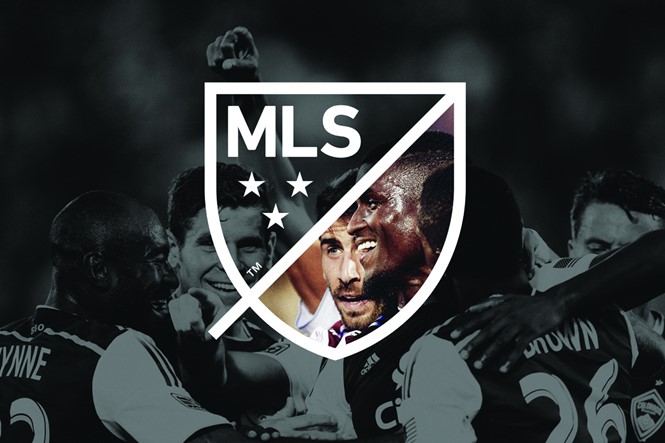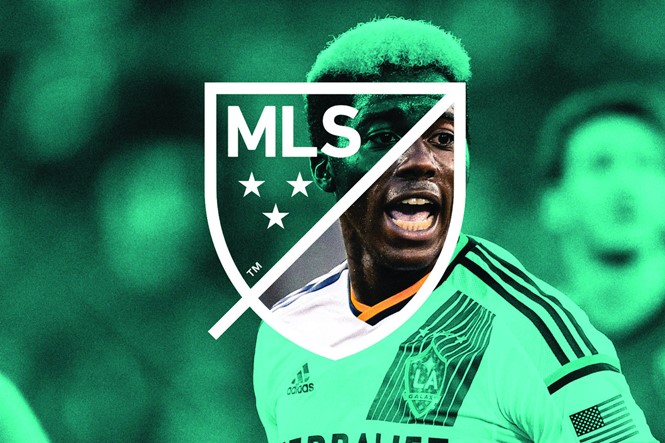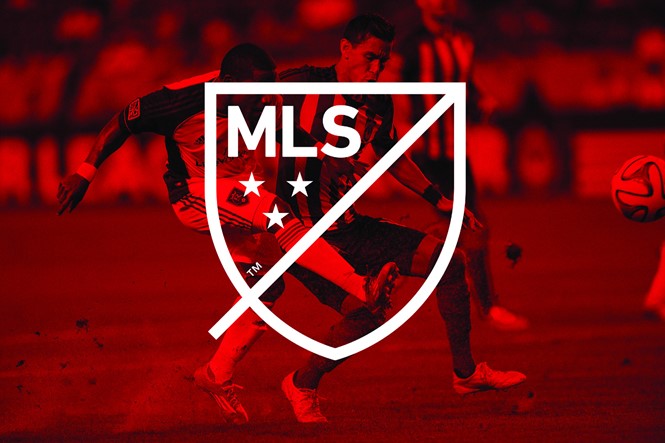Spotlight on MLS
Branding in football, when done right, can revolutionise a team or league for the better. Brittany Golob examines the Major League Soccer and Everton rebrands
The life and times of the modern sports league is no walk in the park, or pitch, for that matter. Football leagues and teams around the world, even in markets as avid as Britain and Latin America, are facing competition for the time, interest and purchasing power fans by other sports.
current leaders in the media have grown up with the MLS, “People who are now in decision-making roles grew up with the game and it was very very rare when the league started. That Millennial audience, that’s an audience in this country that for the most part, doesn’t know life without Major League Soccer.”
A deal announced in May proves that assertion as major US broadcasters Fox Sports and ESPN will share English- language broadcasts while popular Spanish-language channel Univision will have sole Spanish-language rights. Courtemanche says this will help the MLS achieve one of its communications objectives. “Our biggest challenge right now is that there are 70m soccer fans in the United States and millions more in Canada. We need to make sure that all of those soccer fans are also becoming fans of their local MLS club or if you’re in a place like Minneapolis or Sacramento or Des Moines, Iowa, that you adopt an MLS club.” Even in the last couple years, airing bumpers for MLS games during NBC Sports’ broadcasts of Premier League matches increased MLS’ ratings by over 30%.
The design process began by enhancing brand appeal, senior director of brand and integrated marketing at MLS, David Bruce, says. “That is where the flexibility in the system came from. We had to make something that was for everyone and not just for the league office...Consumers connect with brands in newer ways at an increasingly accelerated speed. Who would have thought one of the primary channels for consumers to access brands would be through a small tile on a mobile device? That made us consider the design, ensuring the brand can scale up and down and still be legible and communicate MLS regardless of the size or application.” That versatility across platforms speaks directly to the digital audience, particularly to Millennials and 12-17 year olds.
of North America’s professional football league, Major League Soccer (MLS), until a few years ago, was hardly part of the global conversation about football. Its path to prominence is punctuated by reputational issues abroad, financial woes at home and poor coverage on television. Those days, however, seem to be long gone. The league’s recent rebrand, introduced a new crest, colours and visual identity. Yet, the new brand is only the outward manifestation of the wider communications strategy for the league. In much the same way that the hundreds of different nationalities represented by the populace of the United States is unified beneath a single flag, the new Major League Soccer branding aims to represent its audiences in the US itself, in Canada, in the Americas and beyond.
Those stakeholder groups are comprised not only of the league’s 19 teams spread across the North American continent, but fans in local markets and abroad, the larger soccer community and not least, the broadcasters, online news sources and social media audiences that comment on the sport each day.
Executive vice president of communications, Dan Courtemanche, says, the league recognised early on that the internet was the “sports radio for soccer.” With little coverage on national broadcasts in the early days, the MLS had to be a bit scrappy to build it’s audience.
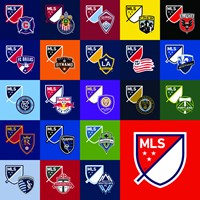
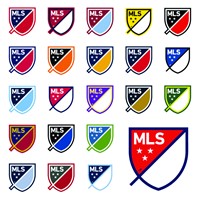
This has changed for the better, says Courtemanche, as current leaders in the media have grown up with the MLS, “People who are now in decision-making roles grew up with the game and it was very very rare when the league started. That Millennial audience, that’s an audience in this country that for the most part, doesn’t know life without Major League Soccer.”
A deal announced in May proves that assertion as major US broadcasters Fox Sports and ESPN will share English- language broadcasts while popular Spanish-language channel Univision will have sole Spanish-language rights. Courtemanche says this will help the MLS achieve one of its communications objectives. “Our biggest challenge right now is that there are 70m soccer fans in the United States and millions more in Canada. We need to make sure that all of those soccer fans are also becoming fans of their local MLS club or if you’re in a place like Minneapolis or Sacramento or Des Moines, Iowa, that you adopt an MLS club.” Even in the last couple years, airing bumpers for MLS games during NBC Sports’ broadcasts of Premier League matches increased MLS’ ratings by over 30%.
The design process began by enhancing brand appeal, senior director of brand and integrated marketing at MLS, David Bruce, says. “That is where the flexibility in the system came from. We had to make something that was for everyone and not just for the league office...Consumers connect with brands in newer ways at an increasingly accelerated speed. Who would have thought one of the primary channels for consumers to access brands would be through a small tile on a mobile device? That made us consider the design, ensuring the brand can scale up and down and still be legible and communicate MLS regardless of the size or application.” That versatility across platforms speaks directly to the digital audience, particularly to Millennials and 12-17 year olds. But strategy must be supported by quality design, particularly when launching a rebrand of a sports organisation. Raphael Wood, brand planner at London- based brand consultancy Springetts, which rebranded the Rugby Football Union and Manchester United, among others, says, “The right brand identity creates a more symbiotic relationship between the sponsors, the media and the league identity...With the right degree of visual equity, if it’s aspirational enough, it can actually add value both to the league itself and back onto the sponsorship and in doing that it becomes more attractive. In being more attractive, it can grow to attract bigger, better sponsors with deeper pockets.”
The MLS brand launch took this to heart. While the league, like most American sports leagues, eschews the European model of the sponsored league brand (ie Barclays Premier League), it launched the new brand system alongside its gaming partner, EA Sports, which released the latest edition of its popular FIFA 15 game concurrently. Alongside traditional sports media relations with Sports Illustrated, Courtemanche says, “We worked with a couple of media outlets to officially break the news before we officially announced it and one of those was Mashable. They have 4.7m Twitter followers and it reach a young, technologically savvy audience. It’s not your traditional sports audience but it reaches an audience that we believe fits in the sweet spot of our target demographic.”
Attention to one’s audience is one of the strongest considerations when rebranding a team or sports league. Any English team that decides to change anything from its colours to its motto to its stadium’s look faces an uphill battle in terms of fan support. Even recently, the move by Cardiff City’s Malaysian owner to turn the team’s colours from blue to ‘lucky red’ prompted massive protests. Last year, Everton FC had trouble after it carried out an in-house rebrand. A crest, in football, is a sacred thing, as Everton’s comms team discovered. The backlash against the design was palpable, prompting the team to bring in sport brand experts, Liverpool-based Kenyon Fraser.
Ben O’Brien, chief executive at Kenyon Fraser says the first step was to research the club, its history, stakeholders and community. “It’s based very much in the heart of the community in north Liverpool. From the perspective of understanding the brand for the club, that history, that tradition is incredibly important to the club. It’s incredibly deeply rooted, it’s very much the DNA, the heart and soul of the club and its incredibly important to the club’s supporters. It’s incredibly important to how the club conducts itself, how it plays football and how it conducts itself off the field as well.”
“We created something that speaks to who MLS is today and where we are trying to tomorrow. This is a modern brand that is seeking to redefine what a contemporary sports league should look and act like”
He says a sports project requires an understanding of stakeholder perceptions, as any other branding exercise, but that in sport, the immense and intense emotions audiences have about the brand make for a comms challenge. “People feel incredibly passionate about their football club. For Everton, that was not in doubt. For some people, that was the main thing in their life. It passed down through generations from parents to children. It’s
a massive responsibility that we wouldn’t take lightly,” O’Brien adds.
The agency eventually delivered three variations of the updated Everton FC crest for a vote by the fans, team, coaches, staff and community. The resulting brand is the reflection of that community’s history and the emotional connections it has to Everton as a team. “Everything that’s [in the crest] is there because it had been used throughout the club’s history and has been reconfirmed with fans and stakeholders to be important,” says O’Brien. For the MLS, O’Brien points out the young league’s teams are still seeking to define their values and drive that passion into the brand. Courtemanche says developing the individual clubs’ support bases has been a key focus for communications and has benefited from a coordinated social media approach, “We’ve seen a massive change in the last decade and moreso even since 2007 when Toronto came into the league. The organisation of supporters’ group and the passion that you see now in MLS stadium is like nothing that we had seen in our early days.”
Major League Soccer has grown through the success of its clubs in their local markets, and the ties those clubs have back to the league which operates on a single entity business model that sees revenue drive back into the league pool from local ticket sales. In essence, the success of one is the success of all. Thus the team owners have a vested interest in the league’s overall success. During the 18-month rebrand, the MLS engaged with a committee of owners and its board of governors to provide guidance throughout.
Thus, the ability of clubs to personalise the brand was one of the most important considerations around the new visual identity. Bruce says the chameleon-like crest that takes on each club’s colours while retaining its identity allows teams and fans to personalise the league brand and make it more a part of their lives. He adds that the most challenging aspect of the rebrand was in, “Creating something that worked for everyone
and managing stakeholders, of which the league has many, to ensure that we created a brand they could be proud of and feel like belonged to them.” Elements of the logo
represent various aspects of football to a modern audience. Ridding the league of its traditional ‘ball and cleat in rectangle’ brand device was a bold step, one that has largely paid off thus far. The crest now represents the global aspect of the sport. Bruce adds, “We created something that speaks to who MLS is today and where we are trying to tomorrow. This is a modern brand that is seeking to redefine what a contemporary sports league should look and act like.”
The league’s maturity allowed it to avoid a reliance on direct visual references to football. “As we become part of the global game and the global football community,
and you look at other global football leagues and their logos, not too many of them have a ball and a cleat in it,” says Courtemanche.
The crest is comprised of a diagonal divide, bisecting the shield at a 45° angle to represent the 45-minute halves of each football game, three stars – representative of club, country and community, and a slash that extends outside the shield to reflect the limitless bounds of football. The blank bottom half of the shield allows people to make the brand their own, effectively bringing them into the MLS community. The red, white and blue reflects the national colours of Canada and the US, the MLS’ two markets. Courtemanche says the shield was selected specifically for its communications qualities. “It represented the global aspect of the sport. The crest or the shield is a significant representation of the sport throughout the world, whether it’s Europe, Latin America, the United States, you name it. We thought it was that modern representation of our league and the world.”
The rebrand, however, is only one step in the communications journey. The MLS seeks to become one of the world’s top leagues by 2022. Its reputation has been augmented by the rising quality of its players, the influx of talent from abroad, and a digitally-savvy audience that has grown up with Major League Soccer.
It’s a far cry from the league’s unstable beginnings, says Courtemanche, when the league was struggling to survive. He adds, “Ten years ago, at that point we didn’t have any teams in Canada, our messaging really started to change where we said, ‘We are the sport and the league for a new America. A new America that’s young, diverse and digital. Our whole strategy really started to pivot toward that audience. Then five years ago or so, we formed our own separate social media team that really helped us connect and engage more deeply with soccer fans throughout North America and the world; connecting with that younger audience, that diverse audience, and doing it for the most part in a digital fashion.”
The lifeblood of sport goes beyond brand, but if a brand can effectively represent the passion that community has for its team, its league or its place in the community, then the brand will succeed and will allow the team or league to thrive, rather than simply survive.
Peer review
Ben O’Brien, chief executive, Kenyon Fraser
Understanding the MLS rebrand from an English perspective is fascinating. Consider the difference. Although
the English Premier League has not been established an awful lot longer than the MLS, it is built on a history stretching back in to the 19th century, with many clubs taking great pride in their history and traditions over many generations.
For any sport, brand understanding and acting on its values and what it stands for in its own mind and that of its fans, customers and stakeholders is fundamentally important to its success. The deeper and more widely held those values are the better. And, of course, the brand needs to help an organisation differentiate itself – clearly demonstrating why it is unique, creating and reinforcing emotional attachment. This is a key challenge for MLS not least because it lacks that history so important in many sports brands and in football clubs in the UK.
It makes sense to have a modernised, unified brand for MLS but if it is to really succeed, it is vital that every club continues to invest in developing its own brand too, identifying what it is that makes them unique as the basis for the relationships between club and fans, players, staff and other stakeholders. And, of course, to help define their rivalry with other clubs!

